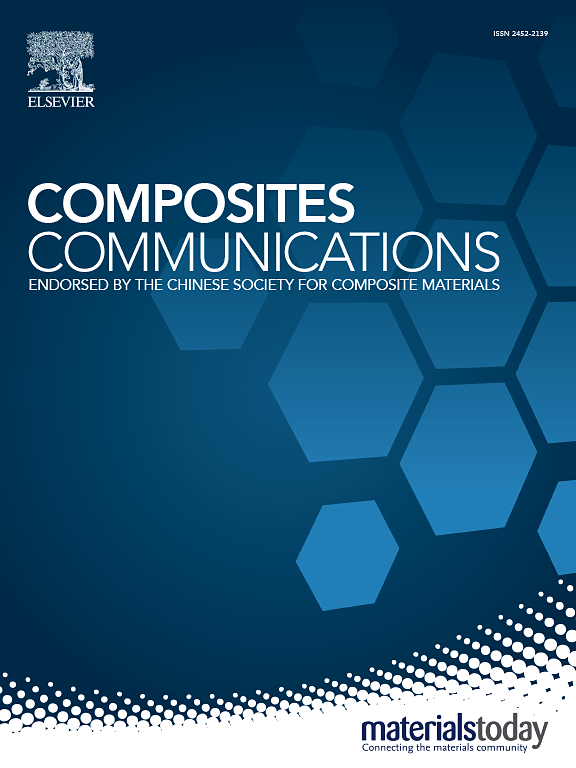Screen-printed large-area wearable graphene-coated cotton fabric-based thermoelectric generator for solar energy harvesting and health monitoring
IF 7.7
2区 材料科学
Q1 MATERIALS SCIENCE, COMPOSITES
引用次数: 0
Abstract
Wearable fabric-based thermoelectric generators (TEGs) have significant potential in the field of self-powered health monitoring. However, achieving solar energy harvesting, stable thermoelectric performance, wearable comfort and scalable production remains a challenge. This study presents large-area, graphene-coated, cotton fabric-based thermoelectric generators (TEGs) prepared using a screen-printing technique with uniformly dispersed graphene ink. These devices demonstrate excellent thermoelectric performance, with a minimum discernible temperature difference of 0.2 K and a fast temperature response time of 1.721 s, as well as solar energy harvesting capability, cycling stability and durability. Due to their temperature recognition and haptic sensing characteristics, the TEGs can quickly detect the different temperature states of water and convert thermal voltage signals from finger contact into English words. When integrated into a mask, the TEG can monitor respiratory rate by detecting the temperature difference between exhalation and the environment. When embedded in a sleeve, the TEG can collect body heat and solar energy synergistically to achieve self-power supply. This study introduces a straightforward, accessible, and scalable fabrication method for graphene-based wearable thermoelectric generators, which exhibit considerable potential for applications in self-powered wearable electronic devices and health monitoring for individuals with visual impairments.

用于太阳能收集和健康监测的丝网印刷大面积可穿戴石墨烯涂层棉织物热电发电机
可穿戴织物热电发电机(teg)在自供电健康监测领域具有巨大的潜力。然而,实现太阳能收集,稳定的热电性能,可穿戴舒适性和可扩展的生产仍然是一个挑战。本研究提出了一种采用均匀分散石墨烯油墨的丝网印刷技术制备的大面积石墨烯涂层棉织物热电发电机(teg)。这些器件具有优异的热电性能,最小可识别温差为0.2 K,温度响应时间为1.721 s,并且具有太阳能收集能力,循环稳定性和耐用性。由于teg具有温度识别和触觉感应特性,可以快速检测水的不同温度状态,并将手指接触的热电压信号转换为英语单词。当TEG集成到口罩中时,它可以通过检测呼气和环境之间的温差来监测呼吸频率。将TEG嵌入套筒中,可以协同收集人体热量和太阳能,实现自供电。本研究介绍了一种基于石墨烯的可穿戴热电发电机的简单、易获取和可扩展的制造方法,该方法在自供电的可穿戴电子设备和视力障碍患者的健康监测中具有相当大的应用潜力。
本文章由计算机程序翻译,如有差异,请以英文原文为准。
求助全文
约1分钟内获得全文
求助全文
来源期刊

Composites Communications
Materials Science-Ceramics and Composites
CiteScore
12.10
自引率
10.00%
发文量
340
审稿时长
36 days
期刊介绍:
Composites Communications (Compos. Commun.) is a peer-reviewed journal publishing short communications and letters on the latest advances in composites science and technology. With a rapid review and publication process, its goal is to disseminate new knowledge promptly within the composites community. The journal welcomes manuscripts presenting creative concepts and new findings in design, state-of-the-art approaches in processing, synthesis, characterization, and mechanics modeling. In addition to traditional fiber-/particulate-reinforced engineering composites, it encourages submissions on composites with exceptional physical, mechanical, and fracture properties, as well as those with unique functions and significant application potential. This includes biomimetic and bio-inspired composites for biomedical applications, functional nano-composites for thermal management and energy applications, and composites designed for extreme service environments.
 求助内容:
求助内容: 应助结果提醒方式:
应助结果提醒方式:


